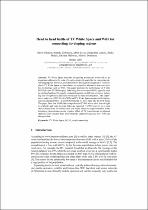 ResearchSpace
ResearchSpace
Head to head battle of TV white space and WiFi for connecting developing regions
JavaScript is disabled for your browser. Some features of this site may not work without it.
- ResearchSpace
- →
- Research Publications/Outputs
- →
- Conference Publications
- →
- View Item
| dc.contributor.author |
Johnson, David

|
|
| dc.contributor.author |
Zlobinsky, Natasha

|
|
| dc.contributor.author |
Lysko, Albert A

|
|
| dc.contributor.author |
Lamola, Magdeline

|
|
| dc.contributor.author |
Hadzic, S

|
|
| dc.contributor.author |
Maliwatu, R

|
|
| dc.contributor.author |
Densmore, M

|
|
| dc.date.accessioned | 2017-06-07T08:01:20Z | |
| dc.date.available | 2017-06-07T08:01:20Z | |
| dc.date.issued | 2016-12 | |
| dc.identifier.citation | Johnson, D., Zlobinsky, N., Lysko, A.A. et al. 2016. Head to head battle of TV white space and WiFi for connecting developing regions. 8th EAI International Conference on e-Infrastructure and e-Services for Developing Countries (AFRICOMM), 6-7 December 2016, Ouagadougou, Burkina Faso | en_US |
| dc.identifier.uri | 8th EAI International Conference on e-Infrastructure and e-Services for Developing Countries (Africomm), 6-7 December 2016, Ouagadougou, Burkina Faso | |
| dc.identifier.uri | http://hdl.handle.net/10204/9230 | |
| dc.description | 8th EAI International Conference on e-Infrastructure and e-Services for Developing Countries (AFRICOMM), 6-7 December 2016, Ouagadougou, Burkina Faso | en_US |
| dc.description.abstract | TV White Space networks are gaining momentum worldwide as an important addition to the suite of wireless protocols available for connecting de-veloping regions. However, there has been no thorough investigation of scenarios where TV White Space performs better or worse than alternative low-cost wire-less technology such as WiFi. This paper analyzes the performance of 5 GHz WiFi links and TV White space links using down-converted WiFi, typically used as wireless backhaul for poorly connected regions, in different scenarios include-ing line-of-sight links and links obstructed by trees and structures. The experi-ments make use of 802.11a/b/g WiFi and TV White Space equipment that down-converts standard 802.11 a/b/g WiFi from the 2.4 GHz band into the UHF band. The paper finds that 5 GHz links outperformed TVWS where clear line-of-sight is available and point-to-point links are required. TVWS however is a clear choice where there are obstructions and where wider coverage is needed. Some interesting observations on the negative effect of TV transmissions in adjacent channels a few channel-hops away from the channel being used for TVWS are also provided. | en_US |
| dc.language.iso | en | en_US |
| dc.relation.ispartofseries | Worklist;18163 | |
| dc.subject | TV white space networks | en_US |
| dc.subject | Wireless networks | en_US |
| dc.subject | e-Infrastructure | en_US |
| dc.subject | Adult language learners | en_US |
| dc.title | Head to head battle of TV white space and WiFi for connecting developing regions | en_US |
| dc.type | Conference Presentation | en_US |
| dc.identifier.apacitation | Johnson, D., Zlobinsky, N., Lysko, A. A., Lamola, M., Hadzic, S., Maliwatu, R., & Densmore, M. (2016). Head to head battle of TV white space and WiFi for connecting developing regions. http://hdl.handle.net/10204/9230 | en_ZA |
| dc.identifier.chicagocitation | Johnson, David, Natasha Zlobinsky, Albert A Lysko, Magdeline Lamola, S Hadzic, R Maliwatu, and M Densmore. "Head to head battle of TV white space and WiFi for connecting developing regions." (2016): http://hdl.handle.net/10204/9230 | en_ZA |
| dc.identifier.vancouvercitation | Johnson D, Zlobinsky N, Lysko AA, Lamola M, Hadzic S, Maliwatu R, et al, Head to head battle of TV white space and WiFi for connecting developing regions; 2016. http://hdl.handle.net/10204/9230 . | en_ZA |
| dc.identifier.ris | TY - Conference Presentation AU - Johnson, David AU - Zlobinsky, Natasha AU - Lysko, Albert A AU - Lamola, Magdeline AU - Hadzic, S AU - Maliwatu, R AU - Densmore, M AB - TV White Space networks are gaining momentum worldwide as an important addition to the suite of wireless protocols available for connecting de-veloping regions. However, there has been no thorough investigation of scenarios where TV White Space performs better or worse than alternative low-cost wire-less technology such as WiFi. This paper analyzes the performance of 5 GHz WiFi links and TV White space links using down-converted WiFi, typically used as wireless backhaul for poorly connected regions, in different scenarios include-ing line-of-sight links and links obstructed by trees and structures. The experi-ments make use of 802.11a/b/g WiFi and TV White Space equipment that down-converts standard 802.11 a/b/g WiFi from the 2.4 GHz band into the UHF band. The paper finds that 5 GHz links outperformed TVWS where clear line-of-sight is available and point-to-point links are required. TVWS however is a clear choice where there are obstructions and where wider coverage is needed. Some interesting observations on the negative effect of TV transmissions in adjacent channels a few channel-hops away from the channel being used for TVWS are also provided. DA - 2016-12 DB - ResearchSpace DP - CSIR KW - TV white space networks KW - Wireless networks KW - e-Infrastructure KW - Adult language learners LK - https://researchspace.csir.co.za PY - 2016 T1 - Head to head battle of TV white space and WiFi for connecting developing regions TI - Head to head battle of TV white space and WiFi for connecting developing regions UR - http://hdl.handle.net/10204/9230 ER - | en_ZA |





